You do not have permission to edit this page, for the following reason:
You can view and copy the source of this page:
Return to Icertis Experience for Word.
This section describes the process of setting up Icertis Experience for Word, both on macOS and Microsoft Windows.
To install ICM Scribe:
1. Obtain the ICM Scribe manifest file.
2. Close all Microsoft Word instances.
3. Remove cache from following folder: /Users/<username>~/Library/Containers/osfMicrosoft.com/Data
4. Click Go on your desktop and then select the Go to Folder.
5. Copy the following path in the field:
/Users/<username>/Library/Containers/com.microsoft.Word/Data/Documents/wef
6. Copy the ICM Scribe installation file (.xml extension) into the wef folder. Once the file is placed on the wef folder, do not modify it manually. Contact ICM support for modifying the installation file.
7. Launch Microsoft Word 2016.
8. Click the Insert tab.
9. Click the My Add-ins drop-down. Select the ICM Scribe icon from the drop-down to enable it on the Home tab.
1. Create a new folder on your C: drive. You can name it as per your preferences, such as ICM Scribe. If you are using a shared machine and want other users to be able to use ICM Scribe on it, share this folder as follows:
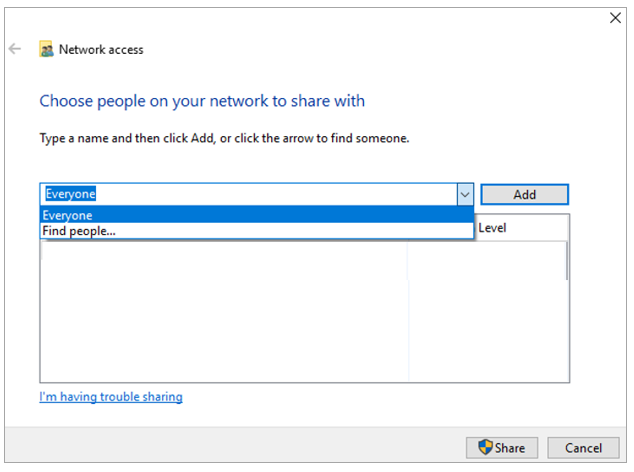
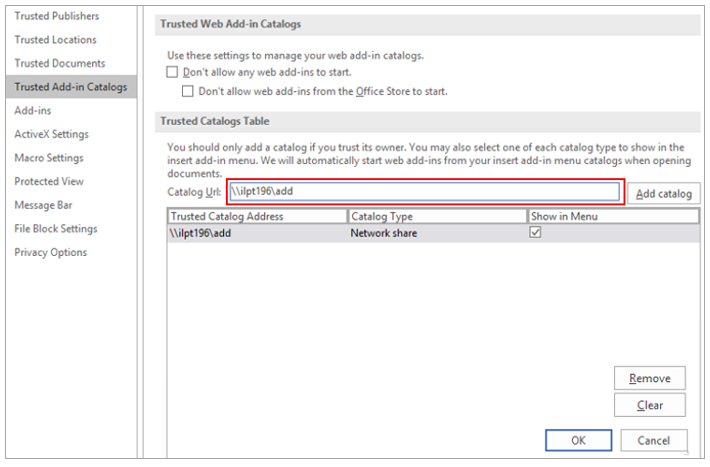
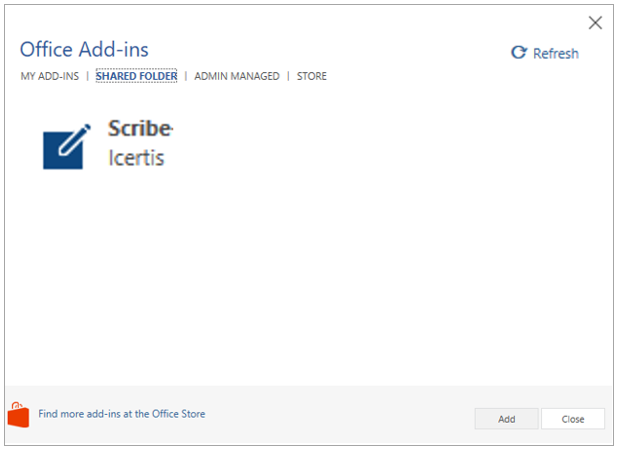
1. Open a new Microsoft Word document.
2. Click the ICM Scribe icon on the Home tab. A default Login browser window opens.
3. Enter the ICM username and password.
4. Click Sign in. You are now logged in to ICM Scribe.
If you have trouble signing in to the ICM Scribe, refer to the Troubleshooting section at the end of this guide.
Here are some helpful tips to have a better experience with ICM Scribe:
Each ICM user plays a specific role in the Agreement workflow. An Administrator assigns roles, and they can be customized as per the business requirements.
You can provide complete access to creating, editing and removing Templates and Clauses from either ICM Scribe or the ICM user interface. This is achieved by managing privileges of entities such as Agreements, Clauses and Contract Types for the selected Security Group from ICM. You can also set the Org Path for specific Security Group users to Root Level.
To manage access privileges for an ICM user:
1. Click User Administration on the Dashboard.
2. Click Users. The list of currently set up users is displayed on the Users page.
3. Click the View Record icon to display the selected user record.
4. Click the Edit button. The Edit User page opens.
5. Click the Organization Unit icon to set the Org Path. The Select Organization Unit page opens.
6. Set the Org Path to Root.
7. Click Ok.
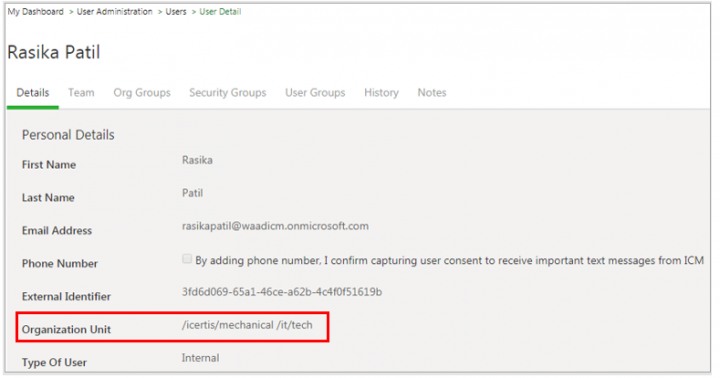
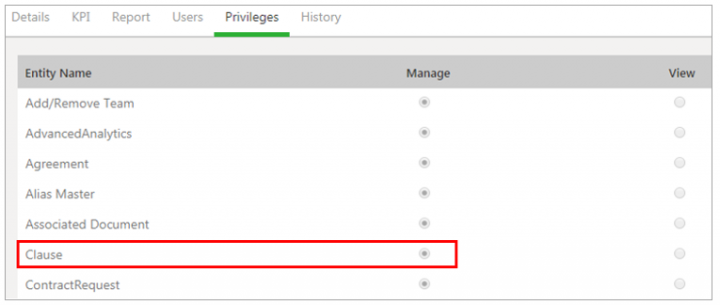
After you log on to ICM Scribe, click the Home icon to view all the actions you can perform using ICM Scribe.
You can create a Template by using ICM Web UI as well as ICM Scribe. Using ICM Scribe, you can:
To create a Template:
1. Click the Create Template button on ICM Scribe Home page. The Create Template page opens. There are two tabs on this page.
(a) Template Details
The following fields are displayed on the Details page:


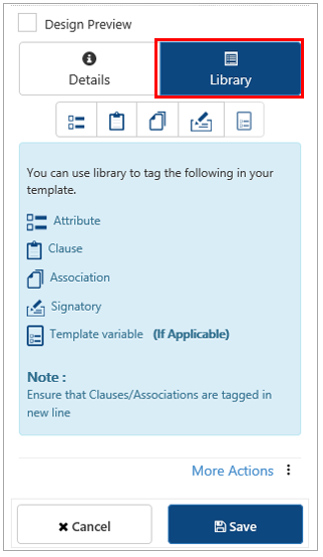
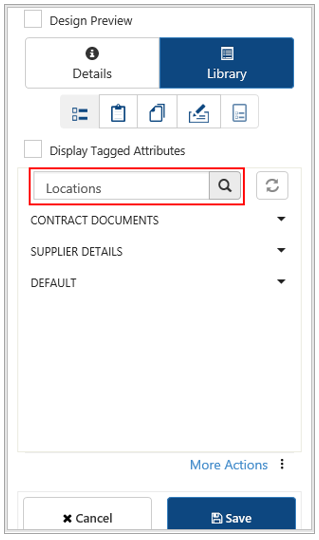
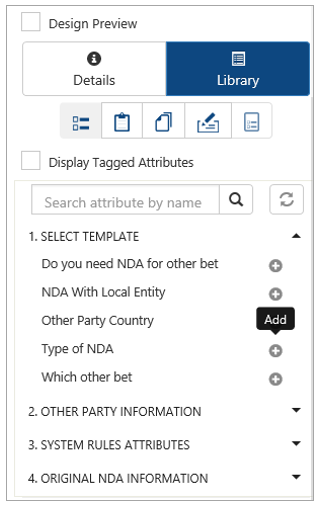
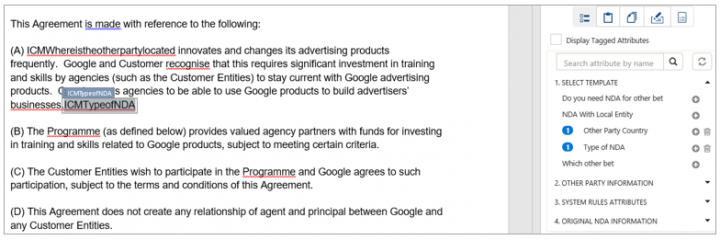
4. Click the corresponding icon to select the appropriate option:
5. Select the Display Tagged Clauses checkbox to view a list of only the Clauses tagged in the Template.
(f) Tagging Associations
To tag associations in your Template:
1. Click the Associations tab in the Library section. You can search for an Association using the Search Associations by name box.
2. Click the corresponding icon to select the appropriate option for the desired Association:

3. Click the corresponding icon to start adding signatory and related tags. You can add the following tags for both signatories:
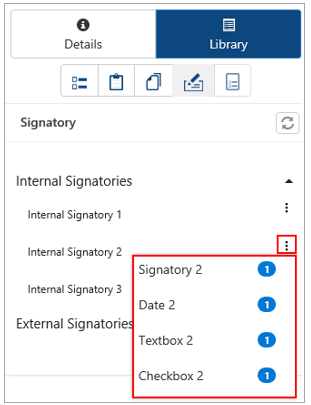
(h) Tagging Template Variables
To save the Template you have just created:
1. Click Save. Validation of the Template is done after clicking Save. The Template has been saved successfully message is displayed along with options:
Template Approvals are done on the ICM Web UI.
1. After clicking the Send For Approval button. The Template has been successfully sent for approval message is displayed. A task is assigned to the approver selected in the Team. If you have not entered all the mandatory information details, you will be redirected to the ICM Web UI on the Edit Template page. Unless mandatory information is entered in the Template Additional Attributes section, the Template cannot be sent for approval.
2. Enter all the mandatory details in the Template Additional Attributes section on the Details section of the Edit Template page.
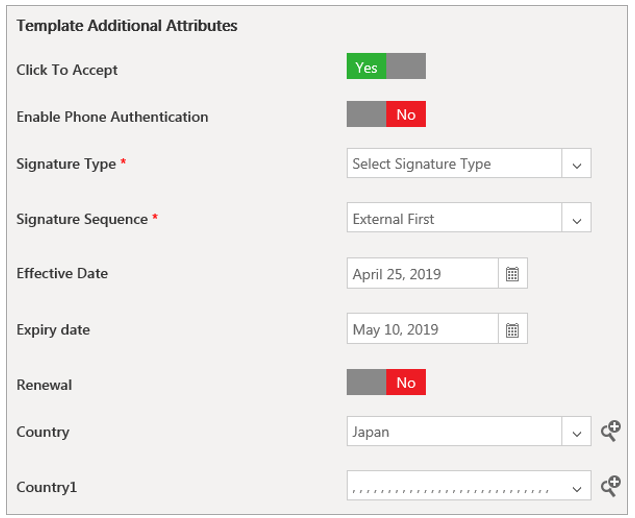
The Edit Template functionality allows you to add or remove Clauses, Attributes, Associations, and Signatories in the Template.
1. Click the Edit Template tab on ICM Scribe Home page. The Templates page opens.
2. Select a Contract Type from the drop-down. A list of all the Templates of the selected Contract Type is displayed. The list includes the top 10 results.
3. Search for a specific Template by typing the first few letters of the Template name or click the Advanced Search Filter icon to find the desired Template.
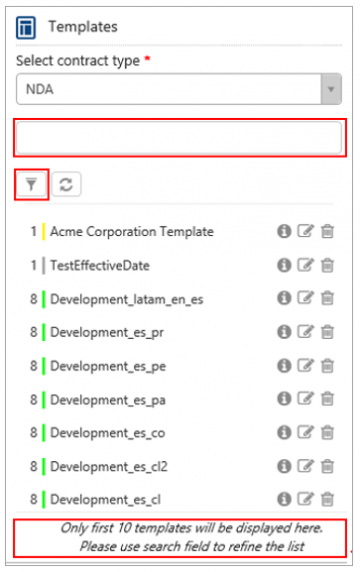
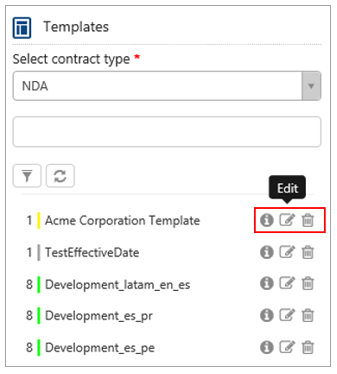
4. Click the corresponding icons to perform various actions on the Template:
To edit a Template:
1. Click the Edit icon next to the Template you wish to edit. The Edit Template page opens.
2. Edit the basic Template details if required on the Details tab. For example, you may want to change the Effective To date or update Version Comments. You need to change the Effective From date to the present or a future date.
3. Add a User or a User Group to the Team if required.
In the Library section, you can add or remove the Attributes, Clauses, Associations, and Signatories as previously explained in the Library section.
On the More Actions menu of the Edit Template page you can see the following options:
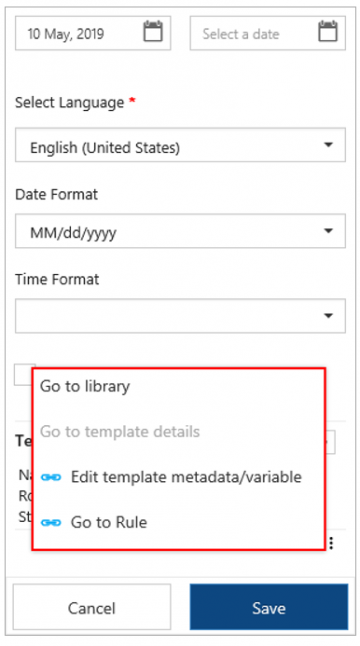
Template Variables are the Attributes specific to the Template. To tag Template Variables into the Template, they must first be created and added into the Template only through the ICM Web. The Template Variables can be tagged into a Template using ICM Scribe by accessing the Template Variable menu from the Library section.
If you haven’t already added the Template Variables using the ICM Web you can save the Template, you are creating and open it on ICM Web. Alternatively, you can go to the Edit Template page and be redirected to ICM Web UI.
To edit Template Variables:
1. Open any Template in Edit mode. The Modify Template menu is only available in the Edit Template mode.
2. Scroll down the page and click the More Actions icon.
3. Click Edit Template Metadata/Variable to view a list of all the Template variables for the selected Template. A popup message is displayed denoting that the Template is now saved, and the user will be redirected to ICM Web to create or add Template variables into the Template.
4. Click OK. You will be redirected to the ICM Web to make additional changes to the Template.
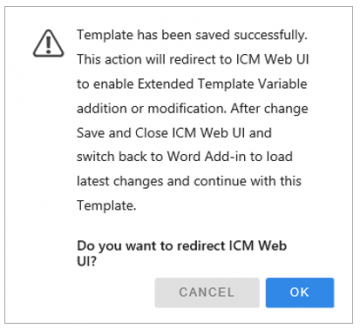
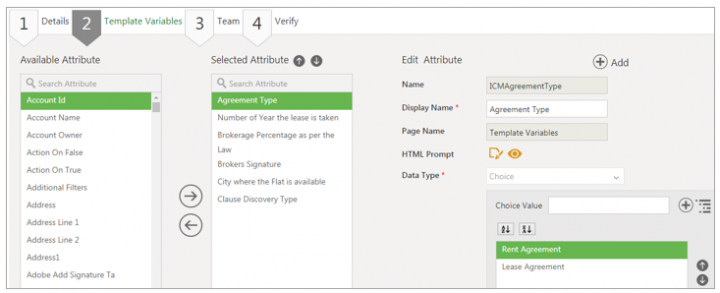
You can create Clauses in ICM Scribe and save them in the ICM repository. Any user with Manage access to the Clauses tile in ICM Web can create a Clause in ICM Scribe.


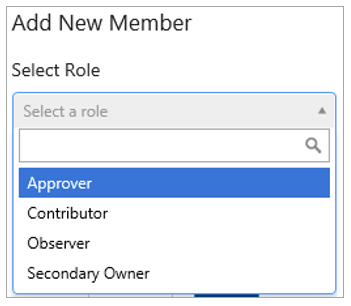
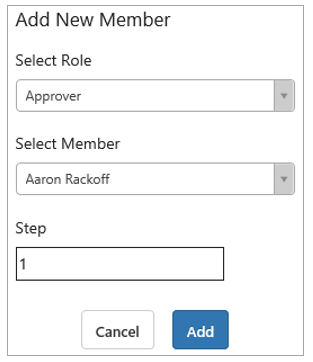

(e) Tagging Signatories
You can add, edit, remove and assign a signatory to your Clause depending on your user access.
To tag Signatories:
1. Click the Signatories tab in the Library section. The signatories are grouped as:

(f) Tagging Template Variables
Template Variables are the Attributes specific to the Template.
To tag Template Variables:
1. Click the Template Variables tab in the Library section. The Selected Contract Types in Clause Details are displayed on this page and greyed out, hence you cannot edit them.
2. Since Template Variables are a part of a specific Template, click the Templates drop-down. A list of all the available Templates is displayed. You can select any number of Templates from the available list.
3. Select the Check all checkbox to select all the Templates.
4. Click Uncheck all to unselect all. After you select The Template(s) all the Template Variables associated with the Template are displayed.
5. Enter your search criterion in the Search bar to search a Template Variable.
6. Click the corresponding Add icon to add the Template Variables tag to the Clause. A number is displayed next to the Template Variable when it is tagged. This number denotes the number of times that Template Variable has been tagged in the document.

(g) Using Design Preview
This feature helps you easily identify the tagged elements in the Clause.
1. Select the Design Preview checkbox to highlight the tagged elements on the Clause indicated by the following color codes:
By default, the Design Preview checkbox is not selected.
To save the Clause you have just created:
1. Click Save. The Clause has been saved successfully message is displayed along with the options:
You can edit Clause details, add or remove Attributes, Signatories, and Template Variables.
To edit a Clause:
1. Click the Edit Clause tab on ICM Home. The Clauses page opens.
2. Select the Contract Type from the drop-down. A list of all the Clauses of the selected Contract Type is displayed. The list includes the top 10 results.
3. Search a specific Clause by typing the first few letters of the Clause name in the Search bar or click the Advanced Search Filter icon to find the desired Clause.
4. The displayed list of Templates is color coded, the colors denote different states of the Template:
You can edit an Agreement in ICM Scribe provided you download the Agreement document from ICM and open it in Scribe. Any user who has Manage privileges on the Agreement can edit the Agreement in Scribe. The Agreement must be in a pre-Approved state.
To edit an Agreement:
1. Open the Agreement document in Microsoft Word.
2. Log on to ICM Scribe. The Agreements page opens. In the Details tab of the Agreements page, the version details of the Agreements are displayed.
4. Click the Library tab to be able to add or edit the tags of various elements.
In the Library tab of the Agreements page, you can tag Attributes, Clauses, Signatories, Template Variables, Agreement Clauses, and Parent Agreement Clauses (if applicable).
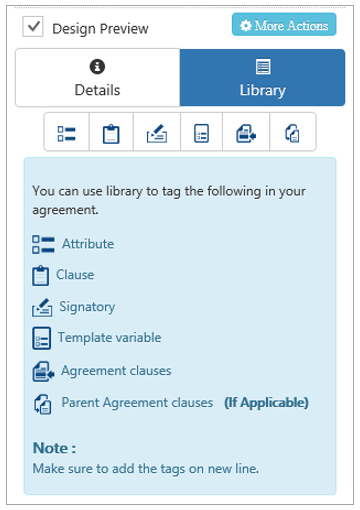
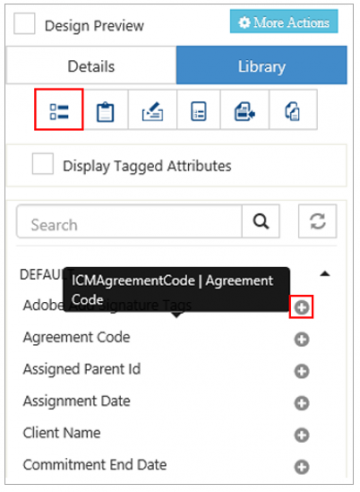
8. Select the Display Tagged Attributes checkbox to view all the tagged Attributes in the Template.
9. Click the Delete icon to remove the Attribute from the Agreement.
(b) Tagging Clauses
All the Clauses that are used in the chosen Contract Type are displayed under different Clause groups that are assigned to the Clause when it is created.
To tag Clauses:
1. Click the Clauses tab in the Library section. A list of Clauses related to the Agreement is displayed.
2. Enter the search criteria in the Search bar.
3. Click the Search icon. Top 10 results are displayed.
4. Click the Advanced Search Filter icon, if you are not able to find the desired Clause.
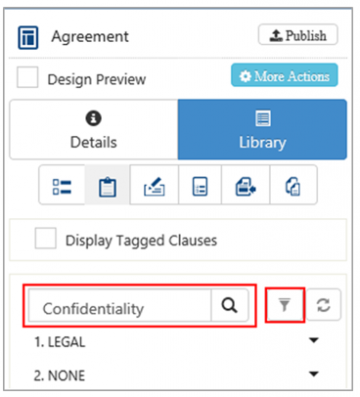
2. Click the corresponding arrow to expand Internal or External Signatories and view the available signatory tags. You can add a maximum of three internal or external signatories.
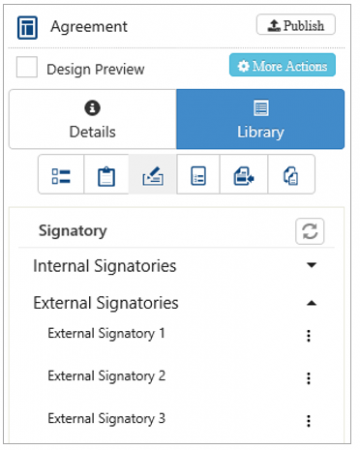
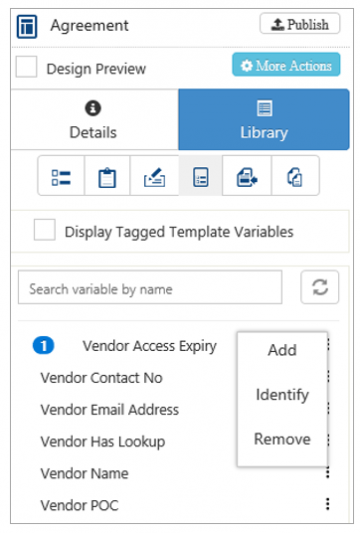


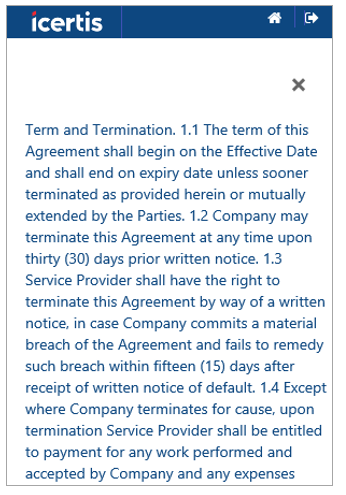
The More Actions button on the Agreement page gives access to a few more functions you can perform on the Agreement. For example, Identify metadata, Identify Clause, Add deviation and Add commitment.
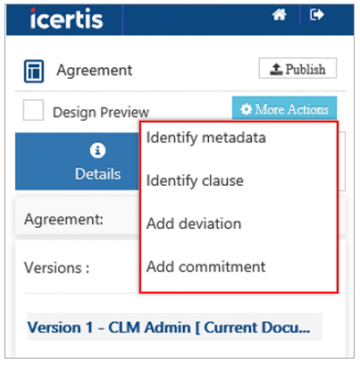

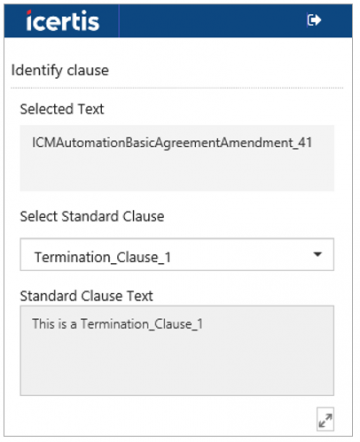
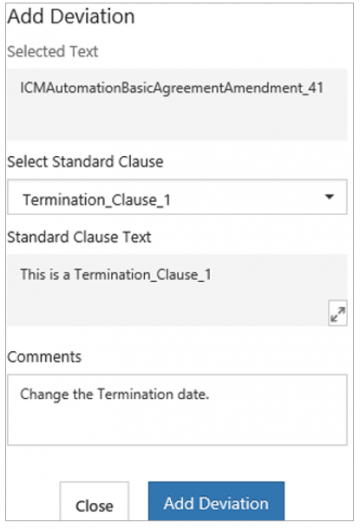
5. Click the Add Deviation button. The deviation added successfully message is displayed. The deviation is sent for approval to follow the standard deviation workflow through ICM Web UI.
6. Click Done. The Details tab opens.

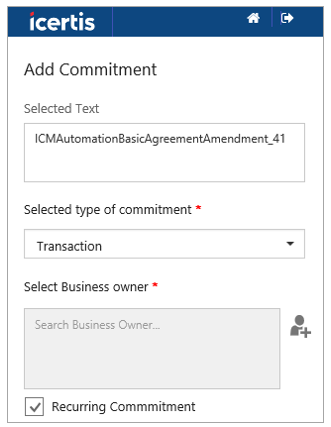
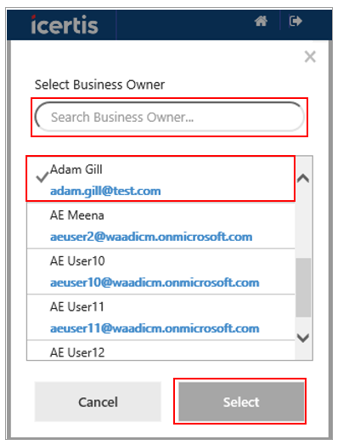
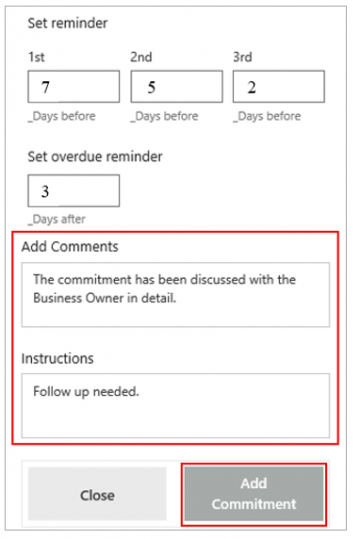
After editing the Agreement, you can publish it to be able to share the updates.
To publish the Agreements:
1. Click the Publish button. The Publish Agreement window opens.
2. Enter relevant comments in the Publish note section.
3. Click Save. The Agreement is uploaded to ICM Web instance.
To view the modifications made to an agreement document:
1. Click the Publish button. The Publish Agreement window opens.
Icertis Experience for Word notifies users about modifications done along with additions and deletions in the tagged attributes, clauses, template variables, and associations of the current agreement before actually publishing it.
2. Enter a relevant message in the Publish note section indicating the update made to the agreement document.
3. Click Save. The validation message opens warning the user of the modifications made to the agreement document to be able to take appropriate actions before proceeding.
4. Click CONTINUE TO SAVE. The Publish Agreement window opens indicating that changes have been identified in the current agreement document with respect to its previous version. The user can review the summary and make informed decisions before actually publishing the agreement.
5. Click View all modifications to see the modifications in the agreement document. The differences in the document are displayed in the Content Control Differences window.
6. Click Yes in the Publish Agreement window of Icertis Experience for Word to save the changes in the document. The validation message opens warning the user of the modifications made to the agreement document to be able to take appropriate actions before proceeding.
7. Click CONTINUE TO SAVE to save the document. The Agreement has been saved successfully message is displayed.
The following table provides activity-wise information on when to use ICM Scribe and when to use ICM Web:
Some issues that you are likely to face when working with ICM Scribe, with applicable Causes and Solutions are listed below.
Related Topics: Agreement Management | Association Management | Compliance Management | Template Management | Clause Management | Configuration | Reports|
You do not have permission to edit this page, for the following reason:
You are not allowed to execute the action you have requested.
You can view and copy the source of this page:
Return to Icertis Experience for Word.